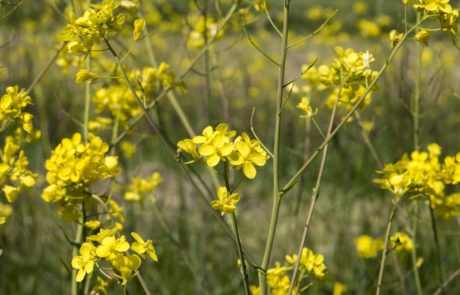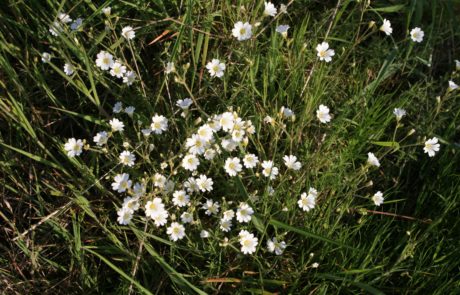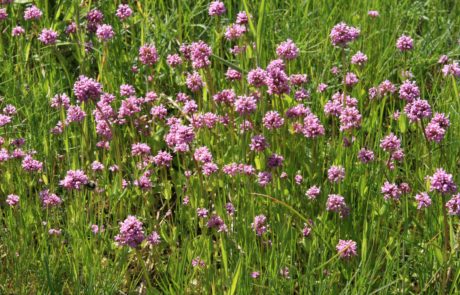Welcome to the world of the Island Marble Butterfly
In 2015, the San Juan Preservation Trust received a grant from the US Fish and Wildlife Service (USFWS) to monitor the current status of the Island Marble Butterfly (Euchloe ausonides insulanus), create new habitat for this imperiled species on protected lands, and to expand outreach to the local community.
This page serves as a general introduction to this amazing endemic sub-species. Contact information, links for further exploration, and an overview of SJPT’s current project to expand habitat for the butterfly are provided near the end of this page.
What is the Island Marble Butterfly and what is its significance to the San Juan Islands?
The Island Marble is a distinct subspecies of butterfly that was originally discovered in 1861 on Vancouver Island, and last seen in 1908 on nearby Gabriola Island in the Canadian Gulf Islands. After nearly 100 years of no reported sightings, in 1998, John Fleckenstein with the Washington Department of Natural Resources “re-discovered” the butterfly at the south end of San Juan Island. Its rediscovery caused considerable excitement among scientists and the general public alike.
Since the Island Marble’s rediscovery, concerted efforts have been made to search for the species, in likely coastal habitat throughout Puget Sound and the Salish Sea (including its historical home in the Gulf Islands and Vancouver Island). Currently, the Island Marble has only been found in small patches (or islands!) of habitat on San Juan Island. As of 2020, it is the San Juan Islands’ newest endangered species.
Photo on right: Island Marble Butterfly on field mustard | Scott McCarthy, USFWS
This is the only known place in the world where this tiny creature lives, and its future lies in our hands.
What does an Island Marble Butterfly look like?
The Island Marble is a medium-sized, creamy white butterfly that measures approx. 1.75 inches (4.5 cm) wing tip to wing tip. It is white above, with black-patterned wingtips, and a fine black rectangle mid-wing. It has a mottled pattern of greenish-yellow on the underwings. The Island Marble’s flight pattern is straight, fluttering, and fast. Marbles may feed and perch with wings either folded or flat.
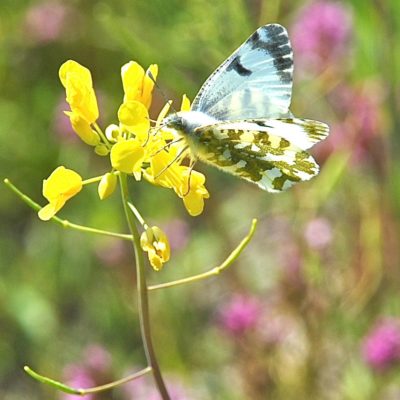 Island Marble adult | Susan Vernon
Island Marble adult | Susan Vernon
The Island Marble adult butterfly is similar in appearance to the common and widespread Cabbage White (Pieris rapae) butterfly, which uses the same host and nectar plants. It can be difficult to tell them apart—especially in flight. Look carefully at perched individuals and note the subtle differences in the markings both on top of their wings (dorsal) and below (ventral). Look for adults on the wing or perched on nectar/host plants from early April- late June.
Other similar butterflies found in the San Juans include the Sara Orangetip (Anchicharis sara) and Pine White (Neophasia menapia). Photos and more information on all of these butterflies can be found here.
Island marble caterpillars have five distinct phases of development, or instars. The caterpillar will have a different appearance with each subsequent molt. A late instar of the Island Marble caterpillar is quite striking: it has very distinctive blue and yellow stripes and is covered with tiny black dots. Island Marble caterpillars can be found most often feasting on their host plant.
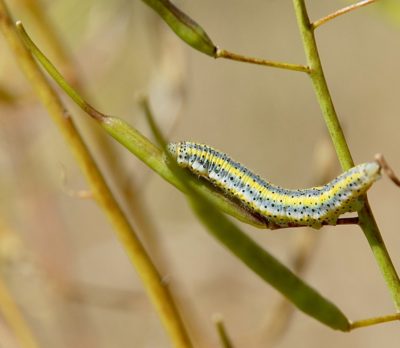 Island Marble caterpillar | Susan Vernon
Island Marble caterpillar | Susan Vernon
What type of habitat does the Island Marble need to survive?
Key Island Marble habitat includes coastal prairie, the margins of saltwater lagoons, gardens, fields, pastures, and disturbed areas.
A requirement of the Island Marble’s habitat is a “host” plant, which provides a place for the butterfly to lay its eggs and food for the growing caterpillars. Host plants include the field mustard (Brassica rapa), quite common in the San Juan Islands. Other important host plants are tall tumble mustard (Sisymbrium altissimum) and tall peppergrass (Lepidium virginicum).
These mustards, when in flower, also provide nectar for the adults. Additionally, adult Island Marbles will feed from sea blush (Plectritis congesta), American searocket (Cakile edentula), small-flowered fiddleneck (Amsinkia menziesii), spring gold (Lomatium utriculatus), field chickweed (Cerastium arvense), and many other native and non-native flowering plants.
Photos from left to right, top to bottom: Brassica rapa | Jeff Brennan, Cerastium arvense | Ferdi Businger, Plectritis congesta | Ferdi Businger, Lomatium utriculatus | Shawn Hubbard.
Island Marble life cycle
The Island Marble inhabits San Juan Island year-round, and even when they aren’t “visible”, they are still with us. In the late spring, adult butterflies emerge from their chrysalis and fly free for only 7-9 days! Within this time; they feed on nectar plants, find a mate, fertilize their eggs, lay their eggs on host plants. After 10-12 days, their egg will hatch into a caterpillar which will feed on the host plants. Caterpillars will advance though five instars (developmental larval stages) throughout about a months time. When they reach full maturity, they will crawl a short distance to form a chrysalis on low vegetation. Here they will remain through the winter and—if all goes well—emerge as butterflies the following spring.
Look closely at the photo below and you’ll see the tiny orange butterfly egg nestled among the flower buds at the top of this field mustard.
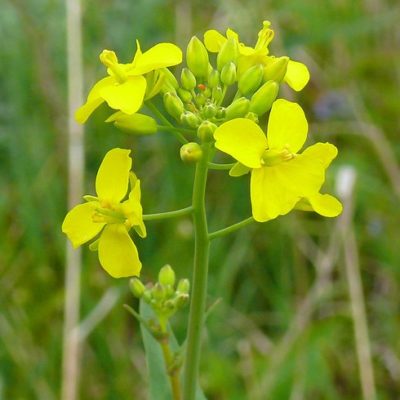 Island Marble egg | Scott McCarthy, USFWS
Island Marble egg | Scott McCarthy, USFWS
What are the threats to their survival?
Any activities that destroy their host plants can threaten the Island Marble’s survival. This can include clearing/development, mowing, deer browse, grazing, plowing, and use of herbicides. While field mustard germinates and grows after ground-disturbing activities (such as plowing and burning), once the mustard plants are established, disturbing the soil or immediately surrounding vegetation can be harmful to any existing populations of the butterflies, as the chrysalis can be destroyed. Additionally, pesticide use on and around plants can kill the adults/larvae outright.
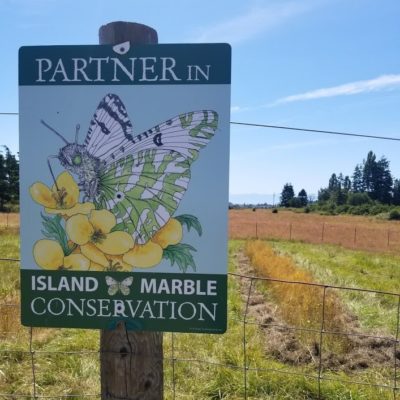
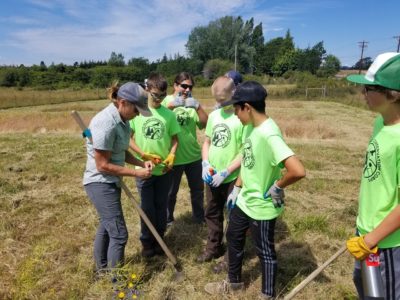

Current status / Research efforts
As of May 4th, 2020, the Island Marble became officially listed under the Endangered Species Act (ESA) because of its rarity and fragility. Efforts to obtain endangered species status for this butterfly had been pursued by several organizations over the course of many years. In 2016, US Fish & Wildlife Service’s first attempt at listing the butterfly under the ESA took place, and again in 2018, USFWS published a proposed rule to list the Island Marble as endangered in the Federal Register (83 FR 15900). The Washington State Department of Fish and Wildlife also listed the Island Marble as a State Candidate species for possible listing as endangered, threatened, or sensitive. Federal listing comes with a designation of critical habitat needs, a coordinated recovery plan, and federal assistance in achieving these goals. The one good thing about becoming listed as an endangered species means that it can lead to more federal funding for the butterfly’s protection and range expansion.
Many partners work together to conserve and protect Island Marble butterflies, including US Fish and Wildlife Service (USFWS), Washington Department of Fish and Wildlife, Washington Department of Natural Resources, San Juan County Land Bank, the San Juan Preservation Trust, The National Park Service, The Xerces Society, Center for Biological Diversity, and a host of private landowners, schools, and concerned citizens.
Before the spring of 2019 and several years prior, the only place in the world where the Island Marble Butterfly was known to still exist, was in an isolated area on the seaside prairie at American Camp (managed by the National Park Service).
The range of this butterfly species officially expanded beyond American Camp, in May of 2019, when a lone female arrived and laid 27 eggs in a Suitable Habitat Patch on Frazer Homestead Preserve, read more about this butterfly’s harrowing journey here.
SJPT’s role
SJPT has received grants from USFWS to create habitat in “safe” areas on three locations on San Juan Island. These safe zones, or Suitable Habitat Patches (SHPs), will be protected from deer browse, mowing, trampling, and insecticides year-round, and are located on lands owned by SJPT and the San Juan County Land Bank. The primary goal of creating these patches is to secure areas where the butterfly can live out its entire life cycle, free from disturbance. Constructed in 2015, these habitat patches are continually maintained and cultivated by SJPT staff with help from the San Juan Island Youth Conservation Corps (SJICC), Washington Conservation Crops (WCC), and SJPT volunteers.
The SHPs are planted with native nectar and host plants that will benefit the butterfly (and other pollinators as well). These SHPs are experimental, though based on methodology from the (successful) American Camp design. All SHPs are closely monitored in an effort to establish the best management practices for plant/butterfly production.
Photos taken in various SHPs— featuring Kathleen Foley Lewis, SJICC, and SJPT volunteer | Staff archive
Where can I report sightings or learn more?
1) Read more about the butterfly on Washington Department of Fish and Wildlife’s page here.
2) Check out SJPT’s Upcoming Events webpage to see if there are any Gardening for Butterflies or other IMB-related opportunities to sign up for and get involved in.
3) A good article/radio piece summarizing the IMB’s status as of August 2017 can be found here. Also, listen to the 2019 interview of SJPT’s Kathleen Foley Lewis on KNKX, here.
4) Report sightings (see note following) to Ann Potter at WDFW (ann.potter@dfw.wa.gov) OR to Kathleen Foley Lewis, Special Projects Director, at San Juan Preservation Trust (kathleen@sjpt.org or 360-378-2461).
5) If you would like to learn more about the SHP project, including information on how you can be involved, please contact Kathleen (contact info above). You can also follow our project updates here.
Please be certain you are looking at an Island Marble butterfly before reporting any sightings. Biologists are especially interested in sightings originating from outside of the south end of San Juan Island. Please use a “hands-off” approach when observing this butterfly. It is illegal under federal law to collect it, even for catch & release, without a permit.
Content for this web page provided in part by the US Fish & Wildlife Service and the Washington Department of Fish & Wildlife.

